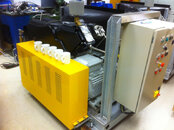So more air over the heads wouldn't be better for cooling?
Interesting question. You may think so. But it's not that easy.
From one perspective more air over the heads would cool faster, I agreed but its not necessarily better.
One big problem is that the one place you don't want hot air condensing out water vapour into water droplets is inside the heads. That creates a steam engine for the simplistic answer and another two pages for the full answer.
No. Water vapour needs to be condensed out inside the cooling coils and then collected in the water separators where it causes the least problems and before it reaches the interstage stage head.
The two (2) other big considerations here to avoid are hydraulicing the heads, as condensed water pressure is not very forgiving or compressible, and work hardening the flexibility of the reed valves on the inlet and discharge valves by work hardening them by a process called quenching.
Now if you are over heating the pump the first thing is read the labels. Second how old is the pump.
Head temps on approach can be measured cheaply with an infra red gun (first spray a small patch of high temp matt black on the cooling coils to give accurate readings.
Granted you could open out the cooling by removing the belt guard (measure with and without the guard) but replacing the solid metal balance driven fully (drive end) will cause you more problems at this stage
Another good solution to consider is the cooling fan fitted to the pump
Is it a 4 blade, a 6 blade, or a UK built 8 blade
Again the blade angle is also a consideration on the UK builds they vary from the quite 0 degree pitch angle to the noisy 30 degree pitch due to it "cutting" more air per RPM revolution.
Not withstanding the location of the compressor and any additional noise considerations, human factor considerations and any legal or statutory obligation of a non military application. Iain






